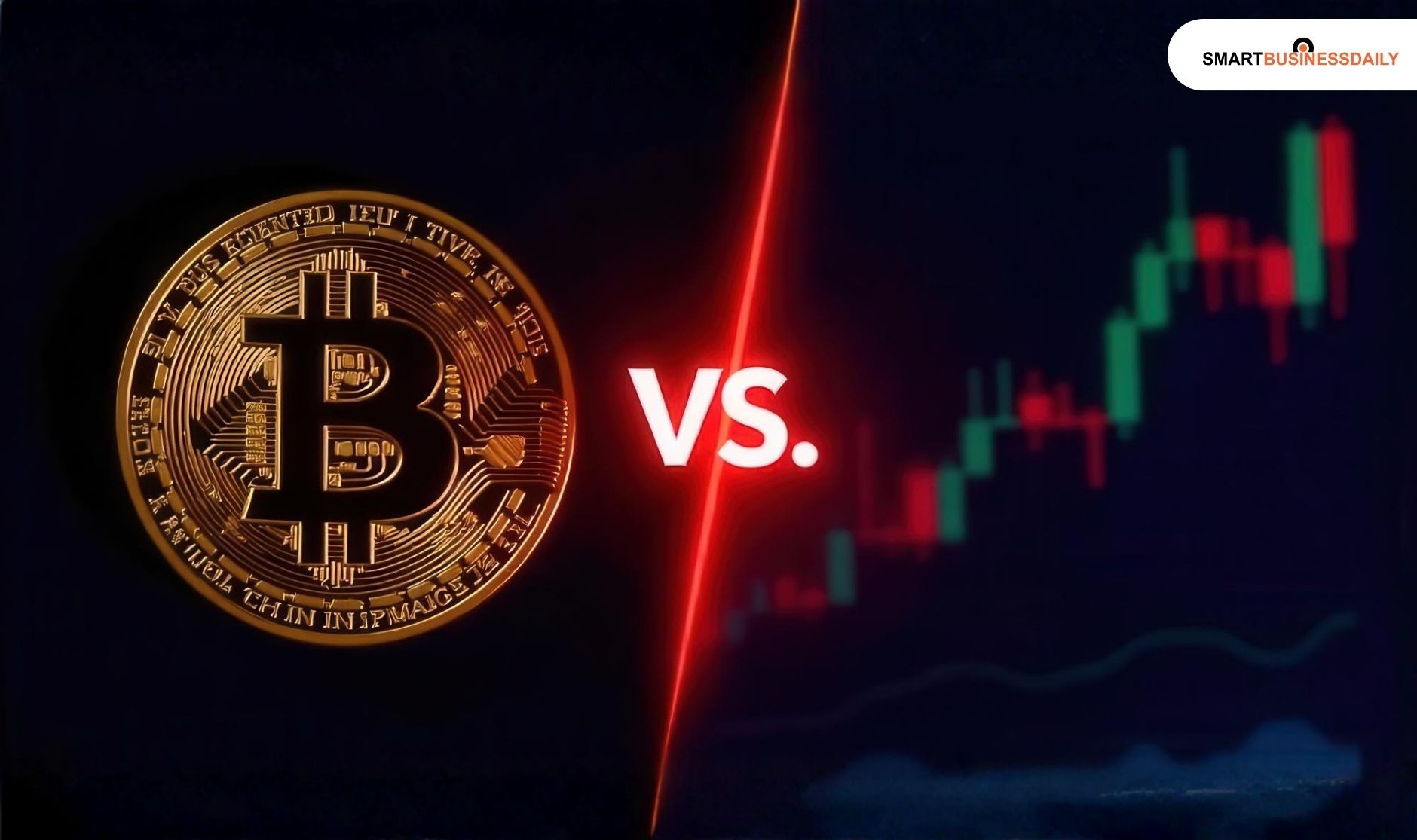Crypto Vs Stocks: Key Differences, Investor Behavior, And Future Outlook
05 November 2025
11 Mins Read

- Understanding The Basics: What Are Stocks And Cryptocurrencies?
- What Are Stocks?
- What Are Cryptocurrencies?
- Crypto Vs Stocks: What Are The Key Differences?
- 1. Ownership And Regulation
- 2. Market Hours And Accessibility
- 3. Volatility And Risk
- 4. Liquidity And Market Depth
- 5. Investor Behavior in Crypto vs Stocks
- » Traditional Stock Investors: Patience and Fundamentals
- » Crypto Investors: Emotion and Speculation
- 6. Technological Foundations: Blockchain vs Traditional Systems
- » Stocks: Centralized, Regulated Systems
- » Cryptocurrencies: Decentralized And Transparent
- 7. Environmental Impact: Sustainability Matters
- » Crypto’s Carbon Footprint
- » Stocks and Traditional Finance
- » Integration With Traditional Finance: The Blurring Lines
- » Banks And Institutional Adoption
- » Central Bank Digital Currencies (Cbdcs)
- » Traditional Finance Meets Defi
- Crypto Vs Stocks: What Are The Different Risks Associated With Each?
- Risk Profiles
- Return Potential
- Correlation Between Crypto And Stock Markets
- Stocks: Built On Trust And Accountability
- Cryptocurrencies: Freedom With Responsibility
- Crypto Vs Stocks: The Future Outlook Of Convergence And Coexistence
- Which Is Better: Crypto Or Stocks?
- Frequently Asked Questions (FAQs)
- Crypto Vs Stocks: The Age-Old Debate Coming To An End
In today’s fast-paced investing world, the debate between Crypto vs Stocks has become a hot topic among everyone from newcomers to experienced investors.
Over the last ten years, we’ve witnessed remarkable shifts in the financial landscape.
Cryptocurrencies have transformed from obscure assets into mainstream investment opportunities, while stocks remain the foundation of traditional investment portfolios.
So, which option is better for investors? To make a smart choice, it’s essential to understand the core differences between crypto and stocks.
It’s also important to grasp how each market functions and what behavioral, technological, and environmental factors can impact its performance.
Knowing these details will help you navigate this evolving landscape more effectively.
Understanding The Basics: What Are Stocks And Cryptocurrencies?

Before diving into comparisons, it’s essential to grasp what each asset represents.
What Are Stocks?
Stocks represent fractional ownership in a company. When you buy a share, you essentially own a small portion of that company.
As the business grows, so does the value of your investment. Stocks are traded on regulated exchanges like the New York Stock Exchange (NYSE) or NASDAQ, and their prices are influenced by:
- Company performance
- Economic conditions
- Market sentiment
Investors often choose stocks for long-term growth, dividend income, and stability.
According to Bankrate, stocks have historically delivered average annual returns of around 10% when measured over decades, making them a cornerstone for wealth creation.
What Are Cryptocurrencies?
On the other hand, cryptocurrencies are digital or virtual assets secured by blockchain technology — a decentralized ledger that records transactions across a global network of computers.
Unlike traditional money or stocks, cryptocurrencies like Bitcoin (BTC) or Ethereum (ETH) aren’t issued by governments or companies.
Instead, they are created through processes such as mining or staking, depending on the protocol.
As explained by Corporate Finance Institute (CFI), cryptocurrencies are designed to be borderless, transparent, and resistant to manipulation.
But their decentralized nature also means they face volatility and less regulatory protection compared to traditional assets.
Crypto Vs Stocks: What Are The Key Differences?
While both serve as investment vehicles, cryptocurrencies and stocks differ in nearly every aspect.
These differences range from how they’re traded to how their value is determined. Let’s break down the major distinctions.
1. Ownership And Regulation
When you buy stocks, you’re purchasing ownership in a company that’s subject to government regulations, corporate reporting standards, and shareholder rights. Stocks are overseen by regulatory authorities such as the U.S. Securities and Exchange Commission (SEC) or SEBI in India.
Cryptocurrencies, in contrast, are largely unregulated or only partially regulated. According to Angel One, this lack of oversight can lead to both opportunity and risk — while it enables innovation and independence, it also exposes investors to scams, hacks, and unstable market practices.
2. Market Hours And Accessibility
The stock market operates within specific trading hours, typically Monday to Friday, 9:30 AM to 4:00 PM in the U.S., with similar schedules worldwide. Crypto markets, however, are open 24/7, enabling trading at any time, anywhere in the world.
This round-the-clock accessibility is one of crypto’s most appealing features. As Cointree notes, it creates a more dynamic trading environment but can also lead to impulsive trading and emotional decisions — especially among newer investors who struggle to disconnect from the market.
3. Volatility And Risk
Cryptocurrency markets are significantly more volatile than stock markets. Price swings of 10–20% in a single day are not uncommon for major cryptocurrencies. Stocks, while also subject to volatility, tend to move within more predictable ranges, driven by fundamentals and broader economic trends.
Smallcase highlights that stocks generally offer a steadier path to long-term returns, while cryptocurrencies can deliver astronomical gains or devastating losses in short periods. Thus, risk tolerance plays a major role in choosing between the two.
4. Liquidity And Market Depth
Stocks have deep liquidity due to institutional participation and decades of market development. Cryptocurrencies are catching up — with trading volumes in the trillions annually — but liquidity can vary widely between tokens and exchanges.
As reported by Capital.com, this liquidity gap means that while it’s easy to trade popular coins like Bitcoin or Ethereum, smaller “altcoins” can experience sharp price fluctuations due to limited buyers and sellers.
5. Investor Behavior in Crypto vs Stocks
One of the most fascinating differences between the two markets lies in investor psychology.
» Traditional Stock Investors: Patience and Fundamentals
Stock market investors typically focus on long-term growth. Their strategies are rooted in company fundamentals — such as earnings, dividends, management quality, and industry performance. These investors tend to hold their shares for years, relying on compound growth.
Behavioral finance studies show that stock investors are influenced by economic news, quarterly earnings reports, and policy changes, but tend to exhibit patience and discipline over time. The presence of analysts, regulations, and institutional investors also stabilizes the market environment.
» Crypto Investors: Emotion and Speculation
Crypto investors, in contrast, are often drawn by innovation and the potential for rapid profit. The market’s 24/7 availability and decentralized nature can amplify emotional decision-making, such as FOMO (fear of missing out) or panic selling during downturns.
As Equiti notes, crypto markets often mirror social sentiment — a viral tweet or regulatory announcement can move prices dramatically within minutes. This high sensitivity reflects both the youth of the market and its unique community-driven culture.
However, the market is maturing. Institutional investors and hedge funds are now entering crypto, bringing a more analytical, data-driven approach. This gradual shift may reduce emotional extremes over time.
6. Technological Foundations: Blockchain vs Traditional Systems
The most fundamental difference between crypto and stocks lies in their technological infrastructure.
» Stocks: Centralized, Regulated Systems
Stocks rely on centralized exchanges like the NYSE, BSE, or NASDAQ, where trades are processed through intermediaries such as brokers, clearinghouses, and custodians. While these systems are robust and secure, they depend on third-party trust and centralized control.
Bison App points out that this structure ensures accountability, but it can also introduce delays, higher fees, and limited access for retail investors in certain regions.
» Cryptocurrencies: Decentralized And Transparent
Cryptocurrencies operate on blockchain technology, which eliminates the need for intermediaries. Transactions are verified through distributed consensus mechanisms — such as Proof of Work (PoW) or Proof of Stake (PoS) — and recorded immutably on a public ledger.
This decentralization enhances transparency and security, as no single entity can alter transaction data. However, it also introduces challenges like scalability issues and energy consumption, especially in proof-of-work systems like Bitcoin.
As CFI explains, blockchain’s programmable nature has enabled innovations like smart contracts, decentralized finance (DeFi), and tokenization of assets, potentially redefining how we invest and exchange value in the digital era.
7. Environmental Impact: Sustainability Matters
Sustainability has become a major topic in investment discussions. Let’s compare how each market affects the environment.
» Crypto’s Carbon Footprint
Cryptocurrency mining, particularly for Bitcoin, consumes large amounts of electricity. A study cited by Bankrate revealed that Bitcoin’s annual energy use rivals that of some small countries. This has sparked concerns among environmentalists and led to increased regulatory scrutiny.
However, the industry is evolving rapidly. The transition of Ethereum from Proof of Work to Proof of Stake reduced its energy consumption by over 99%, setting a precedent for sustainable blockchain solutions.
» Stocks and Traditional Finance
While the stock market doesn’t require energy-intensive mining, it still has an indirect environmental footprint through data centers, trading floors, and financial institutions’ operations. Yet, compared to crypto, the overall impact is relatively lower.
Sustainability is also influencing traditional investing. The rise of ESG (Environmental, Social, and Governance) funds shows that investors are increasingly prioritizing companies committed to ethical and sustainable practices.
» Integration With Traditional Finance: The Blurring Lines
Over the past few years, cryptocurrencies have been gaining traction in mainstream finance — a development that was once considered unthinkable. What began as a decentralized experiment in digital money has evolved into an asset class that institutional investors, hedge funds, and even governments now acknowledge.
» Banks And Institutional Adoption
Major financial institutions like Goldman Sachs, BlackRock, and J.P. Morgan now offer cryptocurrency-related products, such as Bitcoin ETFs or blockchain-based funds. These offerings mark a growing acceptance of crypto as a legitimate financial asset.
According to Capital.com, this integration signifies the beginning of a hybrid era where digital assets and traditional finance coexist, each complementing the other’s strengths. For instance, blockchain technology is being used to improve settlement efficiency, reduce fraud, and enable faster cross-border payments — areas where traditional systems lag behind.
» Central Bank Digital Currencies (Cbdcs)
Another critical development is the rise of Central Bank Digital Currencies (CBDCs). Governments worldwide — from India’s Digital Rupee to China’s Digital Yuan — are exploring state-backed digital currencies to bridge the gap between crypto innovation and monetary control.
Unlike decentralized cryptocurrencies, CBDCs are centrally managed but use blockchain or similar technologies to ensure faster, traceable, and more efficient transactions. This shows that the future of money may not be purely decentralized or centralized, but rather a fusion of both systems.
» Traditional Finance Meets Defi
The emerging field of Decentralized Finance (DeFi) is revolutionizing how we think about lending, borrowing, and trading. Platforms like Aave and Uniswap offer peer-to-peer financial services without banks or intermediaries.
As noted by CFI, the growing collaboration between traditional institutions and DeFi platforms could reshape global finance — merging regulatory safeguards with blockchain transparency. Over time, this integration could make investing more inclusive, accessible, and efficient.
Crypto Vs Stocks: What Are The Different Risks Associated With Each?

Every investor wants to understand one key thing: Which offers better returns — crypto or stocks?
The answer depends on multiple factors, including risk tolerance, investment goals, and market timing.
Risk Profiles
Stocks are traditionally seen as moderate-risk investments. They’re backed by tangible assets, audited financial reports, and government oversight. Cryptocurrencies, meanwhile, are high-risk, high-reward assets driven largely by demand, technology, and sentiment.
As Angel One highlights, the regulatory vacuum around cryptocurrencies amplifies risks — from price manipulation to exchange hacks. In contrast, stock investors benefit from established investor protections, disclosure norms, and insurance systems like the Securities Investor Protection Corporation (SIPC) in the U.S.
Return Potential
Crypto markets can generate exponential gains. Bitcoin’s meteoric rise from under $1,000 in 2017 to over $60,000 in 2021 exemplifies this potential. However, such rallies often come with severe corrections — with drops exceeding 50% being common.
Stocks, by comparison, tend to deliver steadier and compounding returns over time. For example, the S&P 500 has averaged around 8–10% annualized returns historically. While crypto may outperform in short bursts, stocks generally win over longer horizons due to stability and consistent growth.
Correlation Between Crypto And Stock Markets

An emerging topic in modern investing is the correlation between crypto and traditional markets.
According to Equiti, this correlation has increased since the COVID-19 pandemic as global investors began treating cryptocurrencies as risk assets — meaning they often move in tandem with broader market trends.
However, during extreme volatility, crypto can decouple, behaving independently due to unique drivers like regulatory news or blockchain upgrades. This hybrid behavior makes it an interesting diversification tool in a portfolio.
When choosing between crypto and stocks, understanding their regulatory environments is important.
Stocks: Built On Trust And Accountability
Stock markets are governed by well-established laws. Companies must disclose financial data, undergo audits, and adhere to strict governance standards. This transparency ensures a level of trust and predictability that underpins investor confidence.
As Smallcase notes, these safeguards make stocks more stable and less prone to sudden manipulation — an essential factor for risk-averse investors and institutional funds.
Cryptocurrencies: Freedom With Responsibility
Cryptocurrencies offer financial freedom — no middlemen, no centralized control — but with that freedom comes personal responsibility. Users must secure their digital wallets, understand how private keys work, and navigate a largely unregulated space.
Regulatory clarity is gradually improving. Countries like the U.S., U.K., and India are working on frameworks to tax and govern crypto trading. Once these systems mature, the balance between innovation and protection will become more stable, fostering greater investor confidence.
Crypto Vs Stocks: The Future Outlook Of Convergence And Coexistence

The future of investing won’t be about choosing either crypto or stocks — it will likely involve both.
Modern investors are already building blended portfolios that mix traditional equities with carefully selected cryptocurrencies.
The idea is to balance the steady growth of stocks with the exponential upside of crypto.
Financial experts recommend keeping crypto exposure between 5–10% of total investments for diversification without excessive risk.
Blockchain innovations will continue to influence traditional finance. We may see tokenized stocks, on-chain securities trading, and AI-powered trading strategies that merge the best of both worlds.
According to Cointree, these integrations will enhance transparency and accessibility, allowing even small investors to participate in global financial ecosystems seamlessly.
Perhaps the biggest transformation is in investor psychology. The new generation of investors — digital natives — views wealth creation through a tech-driven lens. They value decentralization, accessibility, and community-driven ecosystems.
This evolving mindset means that future markets may not conform to the rigid boundaries of traditional finance. Instead, the lines between crypto, stocks, and digital assets will continue to blur — reshaping what it means to invest.
Which Is Better: Crypto Or Stocks?
Ultimately, the “better” investment depends on your financial goals, risk appetite, and time horizon:
Choose Stocks if you want stability, predictable returns, and exposure to real-world companies with proven track records.
Choose Crypto if you’re comfortable with volatility, have a higher risk tolerance, and believe in the long-term potential of decentralized technologies.
Choose Both if you seek diversification — a balanced approach that harnesses the reliability of stocks and the innovation of crypto.
As Bankrate emphasizes, diversification remains the golden rule of investing. Blending these assets strategically can help you capture growth while minimizing exposure to market shocks.
Frequently Asked Questions (FAQs)
Stocks are generally safer because they’re regulated, backed by companies with tangible assets, and monitored by authorities. Crypto, while promising, carries higher risks due to volatility and limited regulation.
Absolutely. Many investors maintain a diversified portfolio with both asset types. A balanced allocation allows you to benefit from stock stability and crypto growth potential.
No, cryptocurrencies don’t pay dividends. However, you can earn staking rewards or yield through DeFi platforms, which function somewhat like interest returns.
Yes. Unlike stock markets with fixed hours, cryptocurrency exchanges operate 24 hours a day, 7 days a week, enabling trading at any time globally.
Unlikely. While crypto is revolutionary, stocks represent ownership in productive businesses that drive the global economy. The two are more likely to coexist and complement each other.
Crypto Vs Stocks: The Age-Old Debate Coming To An End
The debate between crypto and stocks is not about competition but evolution. Both asset classes serve unique purposes — one rooted in centuries of economic growth, the other in cutting-edge innovation.
Stocks remain the foundation of long-term wealth building, offering consistency and regulatory security. Cryptocurrencies, meanwhile, symbolize the future — a bold step toward financial freedom and digital transformation.
For the smart investor, the question isn’t “Which is better?” but “How can I use both wisely?”
By understanding their differences, risks, and synergies, you can build a future-ready portfolio that thrives in both traditional and digital worlds.



















Comments Are Closed For This Article